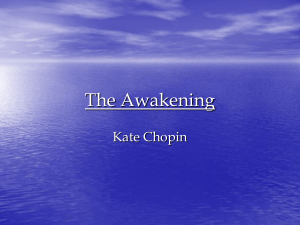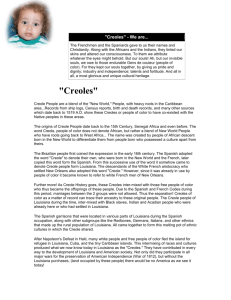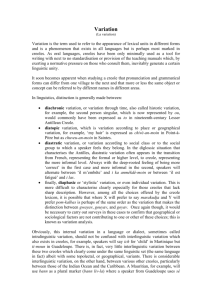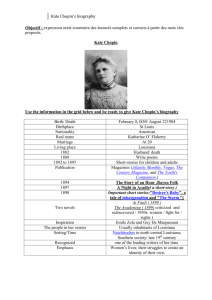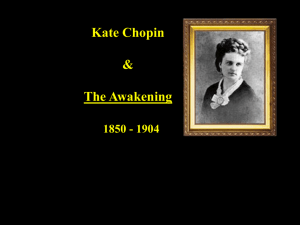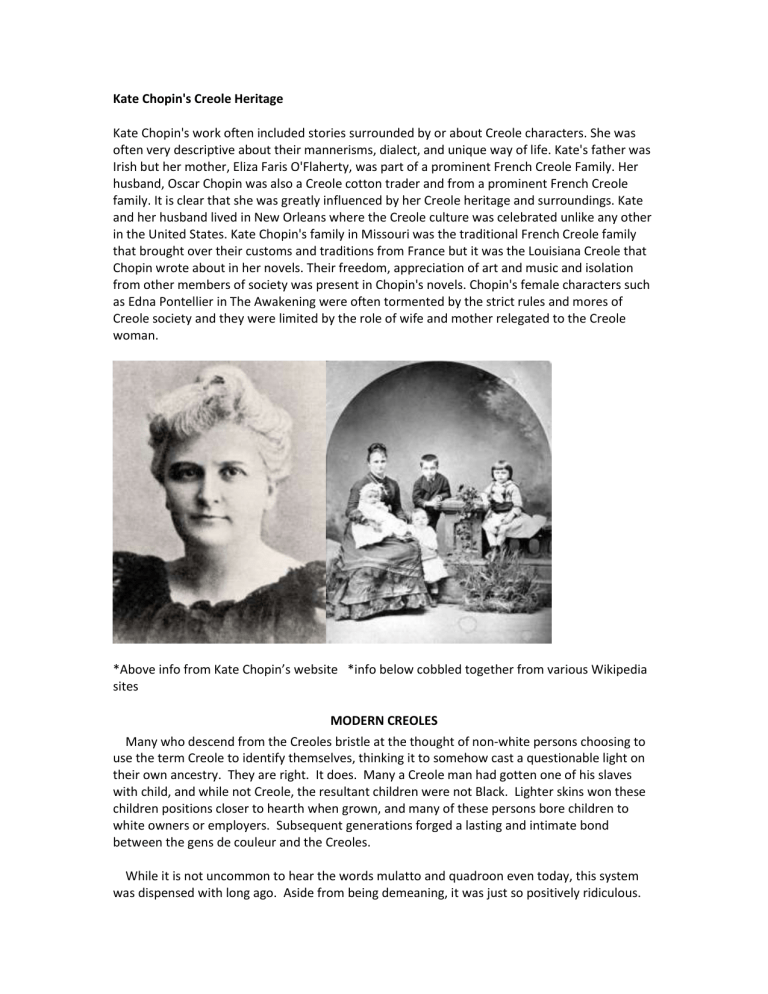
Kate Chopin's Creole Heritage Kate Chopin's work often included stories surrounded by or about Creole characters. She was often very descriptive about their mannerisms, dialect, and unique way of life. Kate's father was Irish but her mother, Eliza Faris O'Flaherty, was part of a prominent French Creole Family. Her husband, Oscar Chopin was also a Creole cotton trader and from a prominent French Creole family. It is clear that she was greatly influenced by her Creole heritage and surroundings. Kate and her husband lived in New Orleans where the Creole culture was celebrated unlike any other in the United States. Kate Chopin's family in Missouri was the traditional French Creole family that brought over their customs and traditions from France but it was the Louisiana Creole that Chopin wrote about in her novels. Their freedom, appreciation of art and music and isolation from other members of society was present in Chopin's novels. Chopin's female characters such as Edna Pontellier in The Awakening were often tormented by the strict rules and mores of Creole society and they were limited by the role of wife and mother relegated to the Creole woman. *Above info from Kate Chopin’s website *info below cobbled together from various Wikipedia sites MODERN CREOLES Many who descend from the Creoles bristle at the thought of non-white persons choosing to use the term Creole to identify themselves, thinking it to somehow cast a questionable light on their own ancestry. They are right. It does. Many a Creole man had gotten one of his slaves with child, and while not Creole, the resultant children were not Black. Lighter skins won these children positions closer to hearth when grown, and many of these persons bore children to white owners or employers. Subsequent generations forged a lasting and intimate bond between the gens de couleur and the Creoles. While it is not uncommon to hear the words mulatto and quadroon even today, this system was dispensed with long ago. Aside from being demeaning, it was just so positively ridiculous. The persons of multi-racial descent, not White, but not embraced by Blacks, sought out a name which was readily accessible, and could identify them, adulterated as their blood was, as an unadulterated group. Creole was handy. Due to the source of the white blood coursing through their veins, and to the fact that history had seen the word so frequently associated with all of their ancestors, it would seem that their claim is as valid as any. Most persons of bi-racial lineage stemming from colonial New Orleans will, if asked, state that they are Black. Some will even label themselves Creole. But the word which once expressed circumstance of birth is now usually applied to the enduring remnants of a rich culture occasionally encountered around and in the city of New Orleans. Louisiana Creole people refers to those who are descended from the colonial settlers in Louisiana, especially those of French and Spanish descent. The term was first used during colonial times by the early French settlers to refer to those who were born in the colony, as opposed to those born in the Old World. The term is now commonly applied to individuals of mixed-race heritage. Both groups have common European heritage and share cultural ties, such as the traditional use of the French language and the continuing practice of Catholicism; in most cases, the people are related to each other. Those of mixed race also have African and sometimes Native American ancestry. The term "French Creoles" came to be applied to Creoles of European or white ancestry. “Creoles of color", came into use in the Colonial era but popularized in the 19th-century, came to refer to mixed-race people of African and European ancestry (primarily French and Spanish), who were native in the area before the Louisiana Purchase. Some Creoles of color may also have Native American heritage. Both groups of Creoles may have additional European ancestry, such as German, Irish or Italian, related to later immigrants to New Orleans. Most modern Creoles have family ties to Louisiana, particularly New Orleans; they are mostly Catholic in religion; through the nineteenth century, most spoke French and were strongly connected to French colonial culture; and they have had a major impact on the state's culture The transfer of the French colony to the United States in 1803 under the Louisiana Purchase and the arrival of Anglo-Americans from New England and the South resulted in a cultural confrontation. Some Americans were reportedly shocked by aspects of the cultural and linguistic climate of the newly acquired territory: the predominance of French language and Catholicism, the free class of mixed-race people, and the strong African traditions of enslaved peoples. Particularly in the South, which was a slave society, slavery had become a racial caste. Many whites considered it a binary racial society, with all who had African ancestry classified as black, regardless of their proportion of white or European ancestry. Although there was a growing population of free people of color, particularly in the Upper South, they generally did not have the same rights and freedoms as did those in Louisiana. The Louisiana territory developed a mixed-race class, of whom there were numerous free people of color. In the early days they were descended mostly from European men and enslaved or free black or mixed-race women. French men took African women as mistresses or commonlaw wives, or even married them. Later, wealthy young white Creole men often took free or enslaved mixed-race women as mistresses or consorts before, or in addition to, their legal marriages, in a system known as plaçage. The young women's mothers often negotiated a form of dowry or property settlement to protect their futures. The men would often transfer social capital to their mistresses and children, including freedom for those who were enslaved, and education or apprenticeships. Mixed-race sons of wealthy men were sent to France for education, while daughters were educated in the local convent schools. As a group, the mixed-race Creoles rapidly began to acquire education, skills (many in New Orleans worked as craftsmen and artisans), businesses and property. They were overwhelmingly Catholic, spoke Colonial French (although some also spoke Louisiana Creole French), and kept up many French social customs, modified by other parts of their ancestry and Louisiana culture. The free people of color married among themselves to maintain their class and social culture. The French-speaking mixed-race population came to be called "Creoles of color". "New Orleans persons of color were far wealthier, more secure, and more established than blacks elsewhere in Louisiana."[ Louisiana French (LF) is the regional variety of the French language spoken throughout contemporary Louisiana in the south-eastern USA by individuals who today identify ethnoracially as Creole. French is not a foreign language in Louisiana. Figures from U.S. decennial censuses report that roughly 250,000 Louisianans claimed to use or speak French in their homes. Louisiana Creole French (Kréyol La Lwizyàn) is a French Creole language spoken by the Louisiana Creole people of the state of Louisiana. The language consists of elements of French, Spanish, African, and Native American roots.
